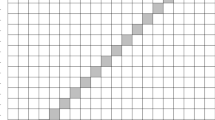Abstract
An infinite lottery experiment seems to indicate that Bayesian conditionalization may be inconsistent when the prior credence function is finitely additive because, in that experiment, it conflicts with the principle of reflection. I will show that any other form of updating credences would produce the same conflict, and, furthermore, that the conflict is not between conditionalization and reflection but, instead, between finite additivity and reflection. A correct treatment of the infinite lottery experiment requires a careful treatment of finite additivity. I will show that the results of the experiment, paradoxical though they may be, are not inconsistent, but that they conflict with one particular version of reflection (special reflection). I will reject that version and I will propose a slight modification of a different version of reflection (general reflection) such that the modified version does maintain the mutual consistency of finite additivity, reflection and conditionalization. As a result, I will strengthen the case for finite additivity by showing that Bayesian conditionalization is fully consistent with it.
Similar content being viewed by others
Notes
I will refer to subjective probabilities as credences.
I will often simply write ‘A’ for ‘\(\hbox {A}\otimes {\varvec{{\mathcal {N}}}}\)’ and, analogously, ‘n’ for ‘\(\{\hbox {A,B}\}\otimes {\hbox {n}}\)’, whenever there is no possibility of confusion.
If \({\varvec{{\mathcal {M}}}}\) is a member of the partition of \({\varvec{{\mathcal {N}}}}, \{\hbox {A,B}\}\bigotimes {\varvec{{\mathcal {M}}}}\) is the corresponding member of the partition of \({\varvec{{\mathcal {S}}}}\). It is the union of sets {(A,n), (B,n)} with n such that q(A) equals r.
“SR” is short for “Special Reflection”, van Fraassen’s name for this principle.
I thank an anonymous reviewer for pointing out the necessity of considering all three principles. That such a conflict exists was already pointed out by Arntzenius et al. (2004) but these authors did not blame conditionalization.
In this and subsequent sums, “j” indicates the summation variable.
Or, more accurately, whether the collection of subsets of N defined by these indicator functions forms an algebra.
The weaker principle that the prior credence in A equals the expectation value, with respect to the prior credence function, of the posterior credence in A is still valid.
van Fraassen (1995) gives a proof of SR assuming GRP, and I will return to that proof later in this section.
f is called q by van Fraassen.
References
Arntzenius, F., Elga, A., & Hawthorne, J. (2004). Bayesianism, infinite decisions, and binding. Mind, 113, 251–283.
Briggs, R. (2009). Distorted reflection. Philosophical Reviews, 118, 59–85.
De Finetti, B. (1972). Probability, induction and statistics. London: Wiley.
Howson, C. (2014). Finite additivity, another lottery paradox and conditionalisation. Synthese, 191, 989–1012.
Schurz, G., & Leitgeb, H. (2008). Finitistic and frequentist approximation of probability measures with or without \(\upsigma \)-additivity. Studia Logica, 89, 257–283.
Van Fraassen, B. C. (1984). Belief and the will. The Journal of Philosophy, LXXXI, 235–256.
van Fraassen, B. C. (1995). Belief and the problem of Ulysses and the Sirens. Philosophical Studies, 77, 7–37.
Weisberg, J. (2007). Conditionalization reflection and self-knowledge. Philosophical Studies, 135, 179–197.
Author information
Authors and Affiliations
Corresponding author
Appendix
Appendix
Define \(\hbox {p}_\mathrm{m}\hbox {(A)} = \hbox {p}_\mathrm{m}\hbox {(B)} = 0.5, \hbox {p}_\mathrm{m}(\hbox {n}{\vert }\hbox {A}) = \hbox {p}_\mathrm{m}(\hbox {n}{\vert }\hbox {B}) = 0\) for \(\hbox {n}>\hbox {m}\), while, for \(\hbox {n}\le \hbox {m} , \hbox {p}_\mathrm{m}(\hbox {n}{\vert }\hbox {A}) = (\hbox {n}^{-1} + \hbox {n}^{-2}) / \hbox {C}_\mathrm{m}\) and \(\hbox {p}_\mathrm{m}(\hbox {n}\vert \hbox {B}) = (\hbox {n}^{-1} - \hbox {n}^{-2}) / \hbox {D}_\mathrm{m}\). \(\hbox {C}_\mathrm{m}\) and \(\hbox {D}_\mathrm{m}\) are normalization constants equal to ln(m) \(+\) terms of order 1. We are interested in the limit of m going to infinity.
First, we find that lim \(\hbox {p}_\mathrm{m}(\hbox {A}{\vert }\hbox {n}) = (1 + \hbox {n}^{-1})/2 > 0.5\). Second, let \({\varvec{{{\mathcal {E}}}}}\) be some subset of \({\varvec{{\mathcal {N}}}}\). In that case, \(\hbox {p}_\mathrm{m}(\hbox {A}{\vert }{\varvec{{{\mathcal {E}}}}}) = \hbox {p}_\mathrm{m}({\varvec{{{\mathcal {E}}}}}{\vert }\hbox {A}) / (\hbox {p}_\mathrm{m}({\varvec{{{\mathcal {E}}}}}{\vert }\hbox {A}) + \hbox {p}_\mathrm{m}({\varvec{{{\mathcal {E}}}}}{\vert }\hbox {B})) = 1 / (1 + \hbox {p}_\mathrm{m}({\varvec{{{\mathcal {E}}}}}{\vert }\hbox {B})/\hbox {p}_\mathrm{m}({\varvec{{{\mathcal {E}}}}}{\vert }\hbox {A}))\). The limit of \(\hbox {C}_\mathrm{m} / \hbox {D}_\mathrm{m}\) equals 1, so the limit of \(\hbox {p}_\mathrm{m}({\varvec{{{\mathcal {E}}}}}{\vert }\hbox {B})/\hbox {p}_\mathrm{m}({\varvec{{{\mathcal {E}}}}}{\vert }\hbox {A})\) equals
in which the sums are taken over all j not exceeding m and in \({\varvec{{{\mathcal {E}}}}}\). This limit is less than or equal to 1 and, consequently, \(\hbox {p}_\mathrm{m}(\hbox {A}{\vert }{\varvec{{{\mathcal {E}}}}}) \ge 0.5\). Equality obtains if the complement of \({\varvec{{{\mathcal {E}}}}}\) with respect to \({\varvec{{\mathcal {N}}}}\) is finite.
Rights and permissions
About this article
Cite this article
Huisman, L. Reflecting on finite additivity. Synthese 192, 1785–1797 (2015). https://doi.org/10.1007/s11229-014-0652-6
Received:
Accepted:
Published:
Issue Date:
DOI: https://doi.org/10.1007/s11229-014-0652-6




